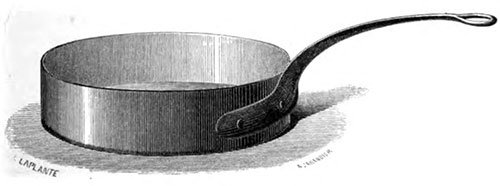Sautéing - Vintage Cooking Process

Sauté Pan © 1869 The Royal Cookery Book
Sautéing is commonly called frying: it consists in cooking with a little fat in a shallow pan. This method is apt to make the articles greasy and is therefore to be used with caution. Butter is generally used, though olive oil is more wholesome.
Sautéing may be also defined as dry frying. Frying proper is effected in a large quantity of fat, oil, butter or lard to enable one to toss things in the pan over the fire. The pan used for this purpose is either a sauté pan, or an ordinary frying or omelet pan. The object of sautéing is partly to stir the contents of the pan and to prevent it from burning.
This must, however, not be performed with a fork or spoon, but my moving the pan frequently backward and forward over a quick fire. A quick and clear fire is needed to cook the article equally throughout.
We sauté potatoes, beans, etc. Liver, to be tossed must be cooked rapidly and kidneys, chicken fillets, etc., are sautéed either in butter, oil or lard. If cut in small, thin pieces, a quick fire is best; if in larger pieces, a more moderate but well-regulated fire is advisable.
Table Talk: The American Authority upon Culinary Topics and Fashions of the Table, Vol. XXVII, 1912, A Series of Articles Published Throughout the Year. Published Monthly by The Arthur H. Crist Co., Cooperstown, NY. A Monthly Magazine Devoted to the Interests of American Housewives, Having special reference to the Improvement of the Table. Marion Harris Neil, Editor.
Sautéing is frying in a small quantity of fat Food so cooked is much more difficult of digestion than when fried in deep fat; it is impossible to cook in this way without the food absorbing fat A frying-pan or griddle is used; the food is cooked on one side, then turned, and cooked on the other.
Fannie Merritt Farmer, The Boston Cooking-school Cook Book, Revised Edition, Boston: Little, Brown, and Company (1912), p. 22
